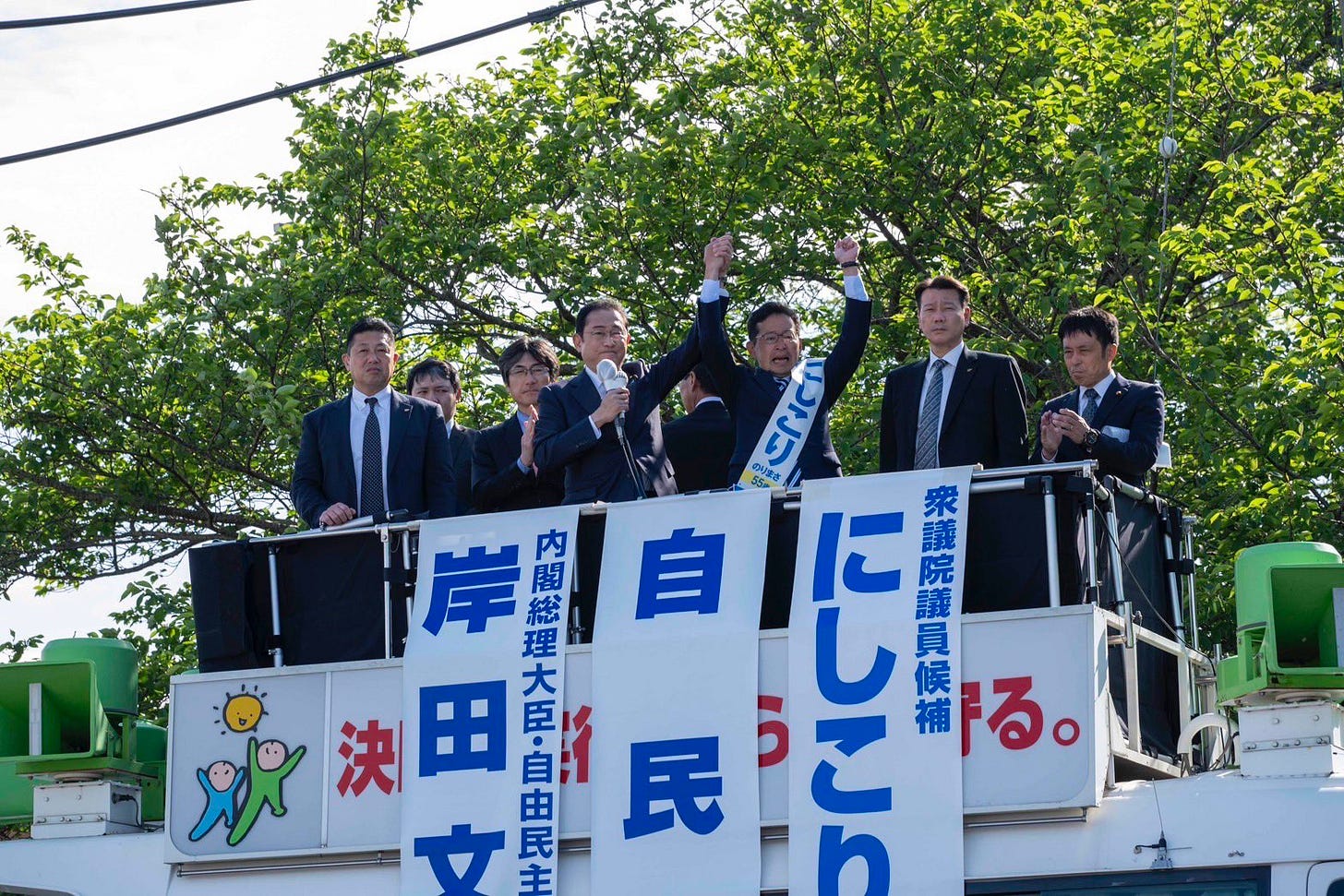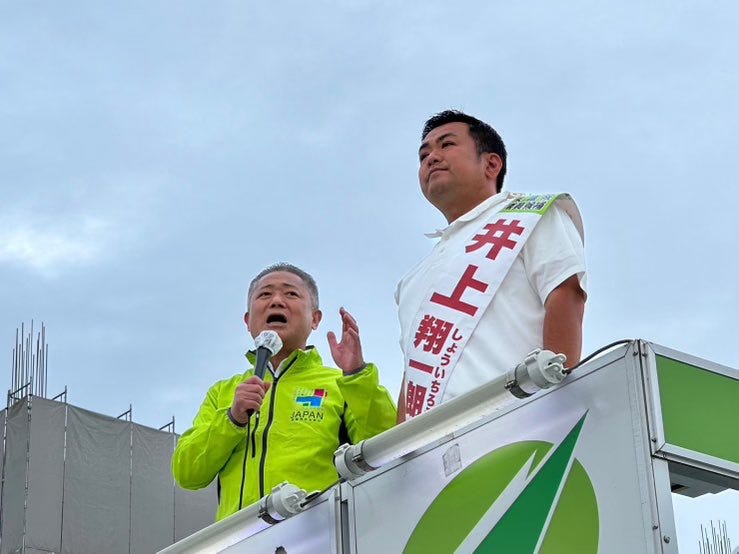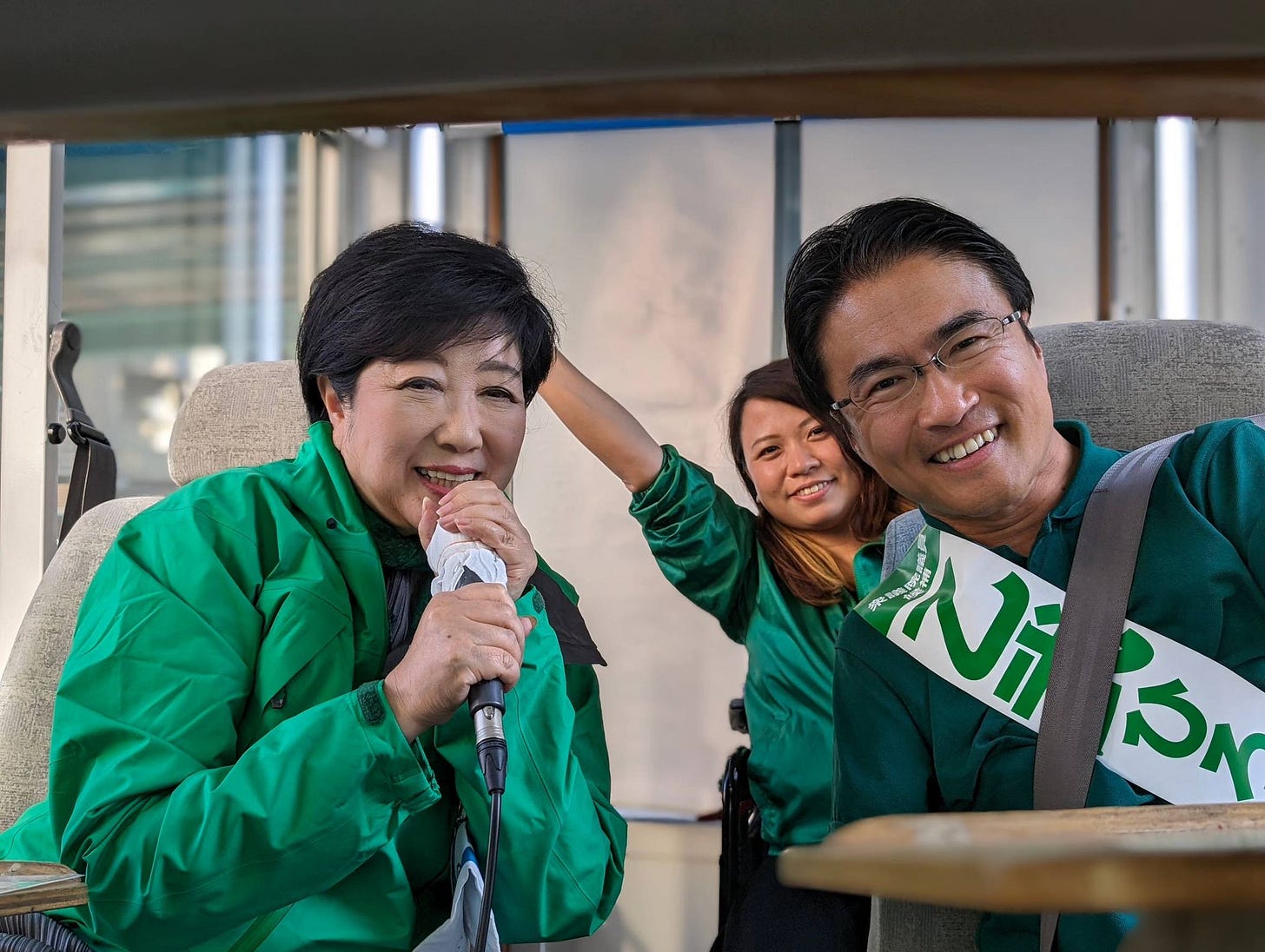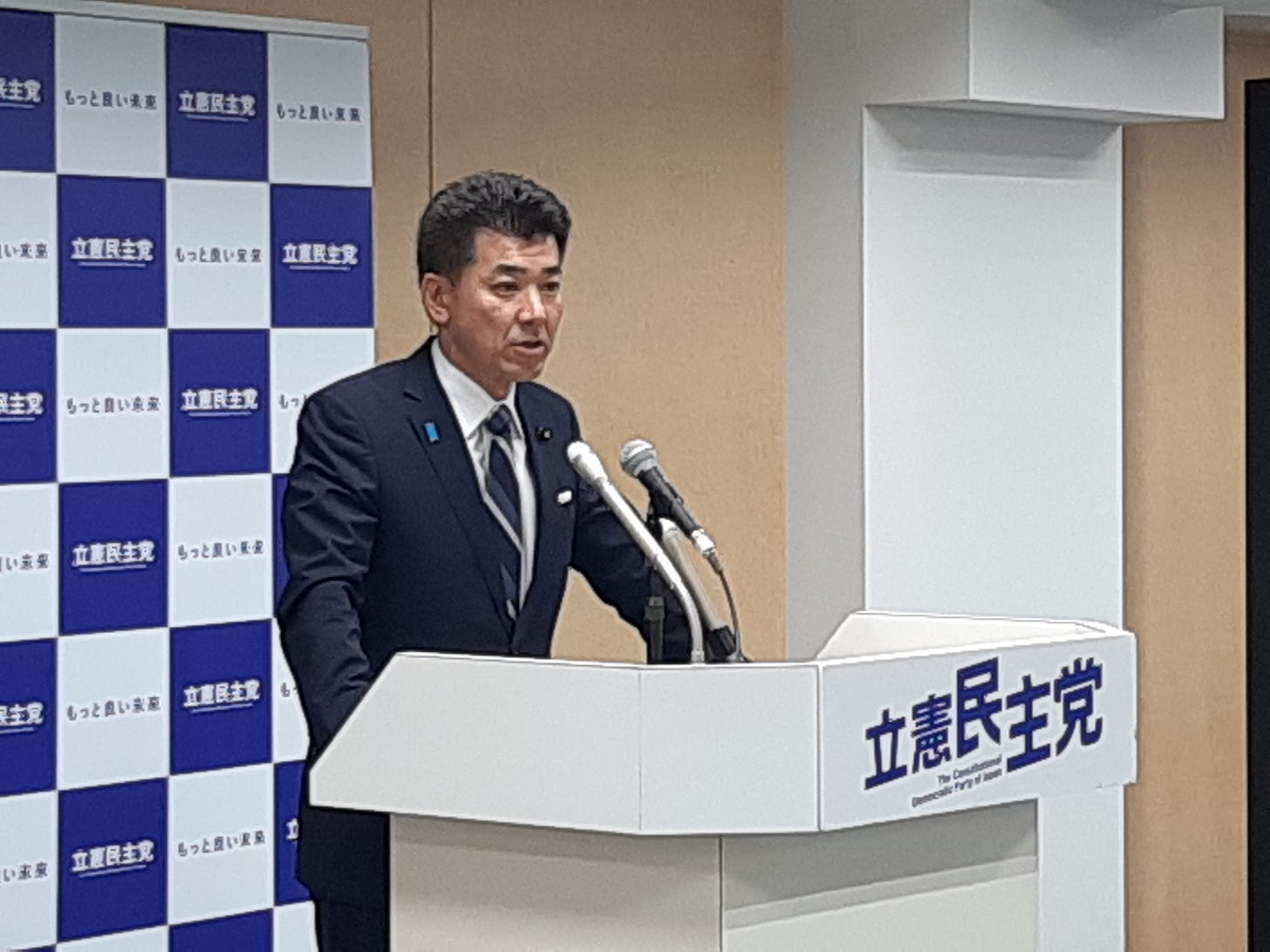Thank you for reading Observing Japan. This post is available to all readers.
If you are looking for timely, forward-looking analysis of the stories in Japans’s politics and policymaking that move markets, I have launched a new service through my business, Japan Foresight LLC. For more information about Japan Foresight’s services or for information on how to sign up for a trial, please visit our website or reach out to me.
The Constitutional Democratic Party (CDP) swept the 28 April by-elections, winning handily in all three races. In Shimane-1, where the CDP's Kamei Akiko faced the LDP’s Nishikori Norimasa, Kamei took nearly 60% of the vote in a district the LDP has never lost. In Nagasaki-3, where the CDP’s Yamada Katsuhiko faced Ishin no Kai’s Inoue Shōichirō, the CDP took more than 68% of the vote. And in Tokyo-15, which featured nine candidates including opposition and independent candidates but no government-backed candidate, the CDP’s Sakai Natsumi took 29% of the vote, enough for a comfortable win and well ahead of Ishin no Kai’s Kanazawa Yui (16.7%) and Koike Yuriko-backed independent Ototake Hirotada (11.5%). It was about as good an outcome as the CDP could have hoped for from the by-elections.
It will take some time for the ramifications of the vote to play out – and low turnout in all three races may make it difficult to extrapolate from the results, not least since the lack of LDP candidates in two races likely depressed turnout – but it is not too early to assess the impact of the by-elections on the national political outlook. Here are the biggest winners and losers from Sunday’s contests.
Winners
Izumi Kenta
During the run-up to the by-elections, there was speculation that Izumi’s job could be in danger when his term as CDP leader ends in September if the party lost any of the three races. By winning all three by significant margins, Izumi’s job may be safe for the time being and he may be able to make the case that he has effectively navigated the LDP’s crisis of confidence to bolster the CDP’s position and fend off Ishin no Kai’s challenge to its status as the leading opposition party. Asahi’s by-election exit poll in Shimane-1 showed Kamei’s taking at least 70% of the independent vote, in addition to taking a portion of the LDP and Kōmeitō vote.
To be sure, Izumi must be careful not to over-interpret the results. The CDP ran strongly but only faced the LDP is one of three races; Ishin no Kai has still not signaled that it is willing to cooperate with the CDP to reduce the number of constituencies where they will field competing candidates in a general election; and Izumi still has to play a balancing act with the Japanese Communist Party (JCP), convincing it to field fewer candidates without making concessions to the JCP that alienate the CDP’s allies in organized labor. There is not necessarily a consensus within the party regarding how to handle these tactical questions.
Still, Izumi and the CDP cleared the bar they had to clear and they now have a tailwind heading into the remaining weeks of the Diet session.
Kōmeitō
The party has been warning Kishida against calling a snap election, and their argument just received a major boost. The junior coalition partner has argued vociferously against any move to a snap election in June or July, and has already cited the by-election results as support for their position that the LDP needs to take political reform legislation more seriously and work to restore public trust before it can even think about calling a snap election.
Right-wing populists

Objectively speaking, the candidates from the two right-wing populist parties in the Tokyo-15 by-election – Iiyama Akari from the newly launched Conservative Party of Japan (CPJ) led by novelist Hyakuta Naoki and Yoshikawa Rina from Sanseitō – performed poorly. Together they received roughly 33,000 votes, or around 20% of the vote, with Iiyama, an academic expert on Islam turned Youtuber and activist, taking 14.2%. While the vote shares of both candidates were likely inflated due to extraordinarily low turnout – only 40.7% of the district’s 430,285 voters turned out – Iiyama’s performance in particular suggests there could be niche for right-wing populism on the margins of the system. Iiyama did, after all, perform better than Ototake Hirotada, Tokyo Governor Koike Yuriko’s handpicked candidate (see below). The Sanseitō already won its first national seat in the 2022 upper house elections (via proportional representation), and the CPJ will seek its own national representation in the next general election. Neither is likely to win a single-member district, but these parties could be poised to profit from disaffection among the LDP’s own voters, which the by-elections suggest could clearly be a factor in the next general election. Hyakuta’s name recognition could be particularly useful in proportional representation balloting.
Losers
Kishida Fumio…

It will be virtually impossible for Kishida to escape the blame for the LDP’s by-election performance, starting with the fact that the party conceded two of three by default. The Abe faction may be at fault for the scandal that has devastated the LDP’s standing, but, after moving quickly to remove Abe faction members from government, Kishida fumbled the response. He took too long to punish wrongdoers (and then invited criticism when the punishments failed to have a coherent logic) and he has failed to articulate a coherent reform agenda that might change the public narrative. He has been a step behind events at every turn. And the public, it seems, is holding him responsible for the entire scandal, to the point that the LDP questioned the value of having Kishida make multiple trips to Shimane to campaign on behalf of Nishikori.
The upshot is that Kishida will find it difficult to play the snap election card before the LDP’s leadership election in September. It was already going to be difficult, but if the LDP had prevailed despite expectations, it might have given the prime minister enough of a boost that he could have used it to prevail over recalcitrants in the LDP in the political reform debate and ride that to snap election after the end of the parliamentary session in June. Instead, he will continue to limp on, with virtually no one in either the LDP or Kōmeitō prepared to defer to the prime minister on the timing of an election. There may not be a coherent anti-Kishida movement at the moment – giving him a glimmer of hope for reelection in September – but if he were to press for a snap election, he would bring such a movement into existence quickly. The result is a stalemate, with no one in the LDP able to force Kishida out ahead of time but Kishida lacking the capability to change the situation himself.
…And the LDP
As bad as the by-elections were for Kishida himself, they were an absolute disaster for his party, starting with its inability to field candidates for two of the three races and then continuing on to its inability to win a seat the LDP has held since the constituency was created under the new electoral system in 1996. The party deployed young, fresh political talents in Shimane-1 – most notably Obuchi Yūko and Koizumi Shinjirō – and it made no difference in the outcome. The Asahi Shimbun’s exit poll suggests that Kamei took roughly a quarter of the votes cast by LDP and Kōmeitō supporters in the constituency; interviews with LDP supporters suggest the party’s brand has been tarnished not only by the kickbacks scandal, but also the Unification Church scandal and checkbook cost-of-living issues. It is difficult to see how the LDP holds an absolute majority in the next general election without a significant change in its fortunes, as the willingness of voters to entertain a vote for the opposition appears to be greater than at any time since the LDP returned to power in 2012.
Ishin no Kai

Ishin no Kai leader Baba Nobuyuki had two chances to show that his party is ready to battle the CDP for the position of leading opposition party beyond its Kansai stronghold and completely flopped. Baba launched Ishin’s by-election campaign with a frontal attack on the CDP, and its rival shrugged off his attacks and bested Ishin’s candidates in both Tokyo-15 and in Nagasaki-3, where the two parties went head-to-head and Ishin’s candidate was blown out. Baba admitted after the by-elections that it is still difficult for the party to win in single-member districts outside of Kansai, suggesting that the party’s ceiling in a general election is still limited. Ishin secretary-general Fujita Fumitake echoed these sentiments, but also said the party would not change its policy of not cooperating with the CDP in the next general election. Ishin’s strength in Kansai means that it could have an indispensable role to play following the next general election, but the party may have to decide whether it wants to play a spoiler potentially by running candidates nationwide who might struggle to win seats but could undercut CDP candidates – perhaps giving it more leverage with the LDP if the ruling coalition’s majority shrinks – or coordinate with the CDP and be a key player in a non-LDP grouping. In any case, the party’s poor performance on Sunday suggests it is not yet ready to surpass the CDP as the leading opposition party.
Koike Yuriko

After speculation that Koike herself would run in the Tokyo-15 by-election, the governor threw her and her Tokyoites First party’s weight behind author Ototake Hirotada, who finished in fifth place, more than 30,000 votes behind the CDP’s Sakai. In a race that was supposed to show Koike’s strength ahead of her bid for a third gubernatorial term in July, the vote instead raises questions about the limits of her power and her ability to play a national political role. Ototake, dogged by reports that resurfaced regarding marital infidelity, also alienated the LDP and Kōmeitō, which had been considering endorsing his candidacy. Koike may still be the favorite in the gubernatorial election, but she has once again shown questionable judgment on a bigger stage.





